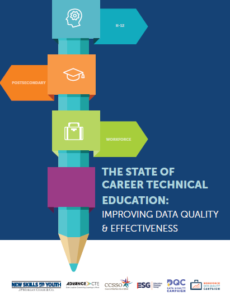 Career Technical Education (CTE) is gaining widespread interest and support from state policymakers, who see it as a strategy to expand access to opportunity and meet employer needs. Between 2014 and 2018, states enacted roughly 800 policies related to CTE, and in 2019, workforce development was one of the top education-related priorities mentioned by governors in their state-of-the-state addresses.
Career Technical Education (CTE) is gaining widespread interest and support from state policymakers, who see it as a strategy to expand access to opportunity and meet employer needs. Between 2014 and 2018, states enacted roughly 800 policies related to CTE, and in 2019, workforce development was one of the top education-related priorities mentioned by governors in their state-of-the-state addresses.
What’s more, in 2018 Congress passed the Strengthening Career and Technical Education for the 21st Century Act (Perkins V), which reauthorized the federal law for CTE and invests around $1.2 billion a year to strengthen and expand CTE programs. The law was enacted in July 2019 and will be in full effect in July 2020 after states submit their four-year plans for CTE to the U.S. Department of Education (see more about the Perkins V planning process here).
With CTE in the spotlight, State CTE Directors are working hard to improve quality and equity in CTE. But state CTE offices often do not have the staffing or resources to conduct rigorous program evaluations to learn what’s working and what needs improvement. By partnering with CTE researchers, State Directors can gain critical insights into the impact of CTE programs, policies and practices.
While the design, governance and delivery of CTE varies from state to state, there are several common questions and challenges across the country that CTE researchers can help address, particularly in light of Perkins V implementation:
Improving program quality: State leaders are working to improve CTE program quality by connecting secondary and postsecondary coursework, integrating academic and technical learning, aligning programs with labor market needs and expectations, and preparing learners to earn industry-recognized credentials of value. Tennessee, for example, recently revised its secondary CTE program standards and developed model CTE programs of study that meet statewide workforce needs. Answers to the following research questions would help fuel these efforts:
- What set of experiences at the secondary and postsecondary levels (CTE coursework, work-based learning, dual enrollment, etc.) best prepares learners for postsecondary enrollment and completion, certificate and degree attainment, and high-wage employment?
- Do these vary by region of the country, Career Cluster® or program of study?
- Does the delivery mechanism (comprehensive high schools, career academies, area technical centers, technical colleges) matter?
Ensuring equitable access and success in CTE: To reverse historical inequities in CTE, state leaders are using data to identify disparities and ensure each learner can access, fully participate in and successfully complete a high-quality CTE program of study. In Rhode Island, the Department of Education repurposed $1.2 million in state funds to launch an Innovation & Equity grant initiative, which provided resources to local recipients to recruit and support underrepresented student populations in high-quality programs. CTE researchers can help these efforts by addressing the following questions:
- What are the classroom and workplace conditions in which CTE students of color are most likely to develop the interests, knowledge, and skills that prepare them to earn postsecondary credentials of value and obtain high-wage employment in their careers of choice?
- What interventions, accommodations, and instructional strategies best prepare learners with disabilities to transition successfully into the workforce?
- How does gender inform the development of occupational identity, and what can educators do to limit the effects of stereotyping on the career aspirations of learners?
Improving the quality and use of CTE data: Most State Directors believe improving and enhancing their CTE data systems is a priority, but only 45 percent say they have the information they need at both the secondary and postsecondary levels to improve program quality. States like Minnesota (through the State Colleges and University System) are working to improve the validity and reliability of their data by collaborating with industry-recognized credential providers to obtain data for their students. CTE researchers can help state leaders improve data quality in two ways:
- Identifying relevant data sources and matching student records to allow for a comprehensive examination of student pathways and outcomes
- Developing and sharing guidance for collecting, validating, and matching student data relevant to CTE
Fostering collaboration and alignment across state agencies: Supporting learner success requires cross-agency collaboration and coordination. State leaders are working to create seamless pathways by sharing data, coordinating program design, and braiding resources to achieve economies of scale. One example is Massachusetts, where Governor Charlie Baker established a cross-agency workforce skills cabinet to coordinate education, workforce, housing, and economic development. The following research questions would help accelerate the work in Massachusetts and other states:
- Do states with policies that foster cross-agency coordination see better education and employment outcomes for students? Can merging datasets across agencies help states better understand and respond to student needs?
- Does credit for prior learning and/or credit transfer between institutions decrease time to credential attainment and entry into employment?
- How does the integration of support services—such as financial aid, Medicaid, Temporary Assistance for Needy Families, and other state and federal programs—impact the likelihood of student success?
Expanding career advisement opportunities: School counselors are the most trusted source of information on CTE and career options, and states are working to bolster their career advisement systems by reducing the counselor-to-student ratio, requiring each student to complete an individualized graduation plan, and developing user-friendly platforms for career exploration. In Oklahoma, for example, it is now policy for all students to identify their career and academic goals through the state’s new Individual Career and Academic Planning program. CTE researchers can help address the following questions:
- Do career and academic planning programs increase the likelihood that learners will complete CTE programs of study, graduate from high school and earn postsecondary credentials?
- How does early career exposure through job shadowing, career fairs and career counseling inform student course taking, academic achievement, and future employment and earnings?
As states chart a vision and path for the future of CTE, they can and should use their data to inform decisions. Researchers can help them collect and analyze high quality data to understand the relationships between CTE program elements and various learner outcomes. This can help them understand what is and isn’t working with current policy and practice and identify how to focus their efforts to improve quality and equity in CTE. In addition, researchers can help state directors plan and conduct rigorous evaluations as they roll out new CTE policies and programs. Over the next few months, Advance CTE and the Institute of Education Sciences (IES) will feature a series of successful partnerships between states and CTE researchers and explore how those projects provided critical data and insights to inform state policy.
This blog series was co-authored by Corinne Alfeld at IES (corinne.alfeld@ed.gov) and Austin Estes from Advance CTE (aestes@careertech.org). IES began funding research grants in CTE in 2017 and established a CTE Research Network in 2018. IES hopes to encourage more research on CTE in the coming years in order to increase the evidence base and guide program and policy decisions. At the same time, Advance CTE has been providing resources to help states improve their CTE data quality and use data more effectively to improve CTE program quality and equity.


 This blog was
This blog was  How many girls of color earned an industry-recognized credential in Information Technology last year? What types of work-based learning experiences lead to the best wage outcomes for learners from low-income families? How many graduates from Career Technical Education (CTE) programs in advanced manufacturing go on to work in their field of study?
How many girls of color earned an industry-recognized credential in Information Technology last year? What types of work-based learning experiences lead to the best wage outcomes for learners from low-income families? How many graduates from Career Technical Education (CTE) programs in advanced manufacturing go on to work in their field of study? Ensuring learners are prepared with the skills and experiences they need for high-wage, high-skill employment in in-demand occupations is a shared responsibility among secondary education, postsecondary education and the workforce sector. Yet too many states continue to use disparate data systems for collecting, validating and accessing learner-level data. Using disparate systems not only increases the data collection burden for local leaders but also threatens the quality of the data and the ability of state leaders to use their data effectively.
Ensuring learners are prepared with the skills and experiences they need for high-wage, high-skill employment in in-demand occupations is a shared responsibility among secondary education, postsecondary education and the workforce sector. Yet too many states continue to use disparate data systems for collecting, validating and accessing learner-level data. Using disparate systems not only increases the data collection burden for local leaders but also threatens the quality of the data and the ability of state leaders to use their data effectively.